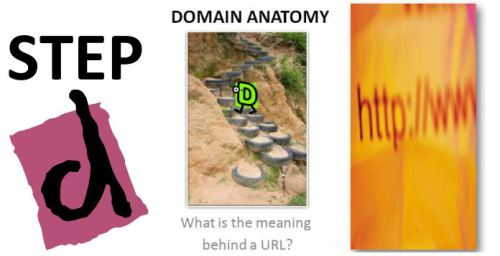Step D- Seven Steps To Website Evaluation For Students: Domain Anatomy

Welcome to a this fourth in a series that is must read for any educator wanting to facilitate web page evaluation by students. It includes a new step in web evaluation information along with a poster for that step you can use in the classroom. Best of all, it supports students becoming scholarly digital citizens. First, to ensure you do not miss one of these valuable posts or other resources covering PBL, Digital Curriculum, Web 2.0, STEM, 21st century learning, and technology integration please sign up for 21centuryedtech by email or RSS. As always, I invite you to follow me on twitter (@mjgormans). Please give this post a retweet and pass it on. Have a great week – Michael Gorman (21centuryedtech)
The Seven Steps to Web Site Evaluation – Step D
Visit the three prior website evaluation posts: A if for Author … B is for Bias … C is for Currency (Just click on the letter)
D Is Domain Anatomy
Much can be determined by looking at the address of a website. Such things as sponsoring organization, type of organization and its intent, country of origin, and file names can all be gleaned from the address of a site. A good research technique involves studying and dissecting the web URL (domain anatomy) in order to determine if it fits the research being performed.
1. Know The Main Domain – The main domain (Actual Domain) usually gives away the sponsoring organization name. In the case of http://www.biginfo.com/ca/infile.html(not really a link) , the section entitled “biginfo” is considered the Main Domain. It is the letters between the first two dots in the web address. Knowing the Main Domain can be very valuable because of its possible link to an organization. The Main Domain may also give away the purpose. There is a chance that the Main Domain (Actual Domain) could be a slogan instead of organization name. Consider the case of http://www.outlawgumchewing.org/stickyrules.htm.(not really a link) The Main Domain“outlawgumchewing” may actually contain the agenda rather than organization name. The Main Domain could also be a person or publications name. Last, the Main Domain may be insignificant or could distract you from the real organization. It is always a good idea to look in the web page to see if the actual sponsor relates with the Main Domain. Sometimes it may be a good idea to view only the Main Domain by including all characters up to the Top Domain (Suffix) as explained below. This may take the researcher to the main sponsor page.
2. Know The Top Level Domain – The Top Level Domain usually comes after the Main Domain and is a two or three letter code identifying the type of website. This Top Level Domain (TLD) may also contain a two letter country code identifying the country of origin. Understand that the country code may not always be part of the suffix (TLD). In the case of http://www.biginfo.com/ca/infile.html(not really a link) , it can be seen that “com/ca” is the Top Level Domain (TLD). The portion “com” identifies the type of website as being commercial/business. The “ca”portion identifies country of origin as Canada. There will not always be a country code and, in that case, country for users in the United States is probably the USA (consider host country of researcher). Knowing the Top Level Domain (TLD) that contains this site identification and country can be useful. The country of origin could have a bias on topics (such as “Space Race” if origin is US compared to RU, or even “American Revolution” if origin is US as compared to UK). The site identification portion of Top Level Domain (TLD) is outlined below and could give hints toward a website’s purpose.
- .com business, commercial, company (usually profit minded)
- .edu usually a college or university
- .k12 k12 – school usually followed by state abbr. and US
- .org organization, club, interest group
- gov government agency
- .mil military interest
- .net independent organization, non profit, non educational
- .int international group
- .us country code check http://www.iana.org/domains/root/db/
3. Recognize The Mapping – In most cases the rest of the address after the suffix identifies the file name and page name of the particular page as it resides on the host computer.
Tools and ideas to transform education. Sign up below.
4. What Does It Mean? – Using the above information, does it have any determining factor as to whether the page can be a valuable part of intended research.
Download Poster Here: d1_poster_info
Enjoying the series?… Please let me know by email, response, and sign up… and please share with a Retweet!
cross-posted at 21centuryedtech.wordpress.com
Michael Gorman oversees one-to-one laptop programs and digital professional development for Southwest Allen County Schools near Fort Wayne, Indiana. He is a consultant for Discovery Education, ISTE, My Big Campus, and November Learning and is on the National Faculty for The Buck Institute for Education. His awards include district Teacher of the Year, Indiana STEM Educator of the Year and Microsoft’s 365 Global Education Hero. Read more at 21centuryedtech.wordpress.com.
